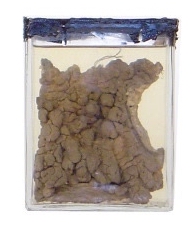

Department of Surgery Jars
| Description | Colon Polyps |
| Author | Department of Surgery |
| Copyright | Cairo University - Faculty of Medicine |

Diagnosis
Colon polyps
Some possible questions
Q: is this a segment of small intestine, colon or rectum?
Clue: look at the back of the jar.
Q. what is the differential diagnosis?
Q. What are the clinical features?
Q. What are the possible complications?
Q: What is a polyp?
A: It is an elevation of the mucosal surface, usually consisting of a
rounded projection into the lumen .
Q: Which colonic polyps have a malignant
potential?
A: Adenomatous polyps are known for their malignant potential.
Q: What are different types of Adenomatous polyps?
Tubular : the covering epithelium is arranged in closely packed
tubules resembling the tubular glands of the colonic mucosa.
Villous : the epithelium is thrown into numerous fronds each is formed
of a single layer of epithelium around a central core of vascular stroma.
Tublu-villous : a combination of both forms.
Q: Which polyps have no
malignant propensity?
Hyperplastic polyps.
Hamartomas.
Inflammatory: Crohnâs disease, ulcerative colitis and bilharzial
colitis.
Q: Is there a relation
between cancer risk and the size of the polyp and its histology ?
A: Yes, the larger the polyp the more the risk (<1 cm
1-10%-- >2 cm 30-50%.
Tubular adenomatous polyps are less risky than the villous form, and the
mixed forms lie in-between.